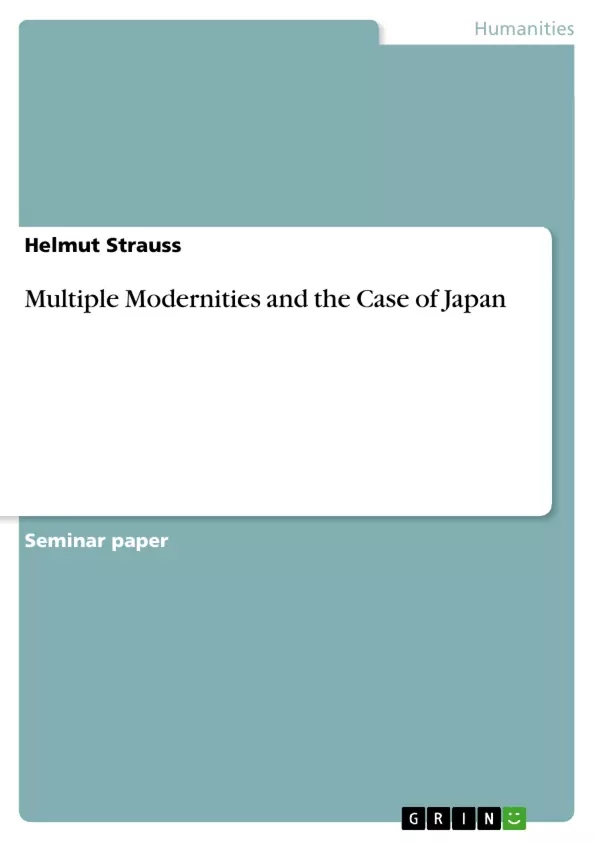“1. Deliberative councils shall be widely established and all matters decided by public
discussion.
2. All classes, high and low, shall unite in vigorously carrying out the administration of affairs
of state.
4. Evil customs of the past shall be broken off and everything based upon the just laws of
nature.
3. The common people, no less than the civil and military officials, shall each be allowed to
puse his own calling so that there may be no discontent.
5. Knowledge shall be sought throughout the world so as to strengthen the foundations of
imperial rule” 1.
These progressive pledges constituted the programmatic Charter Oath, issued by the Meiji
emperor in April18682 and marking the official beginning of the Meiji restoration.
Only fifteen years after the arrival of Commodore Matthew C. Perry’s “Black Ships” 3 and the
forced opening to the world in 1853, Japan embarked on a rapid and successful modernizing
process.
By 1894, the Japanese modernization was already seen as a role model for other nations; the
Chinese revolutionary Sun Yat-sen wrote in that year: “The first step in China’s revolution
was the Meiji Restoration; the Chinese revolution is the second step in the Meiji revolution” 4.
Instead of suffering the “fate of semi-colonialism” 5, Japan was able to start an own
diplomacy of imperialism6. [...]
1 Jansen, Marius B.: The Making of Modern Japan, Cambridge, Mass. & London 2000, p. 338.
2 Jansen, Japan, p. 337.
3 Jansen, Japan, p. 277.
4 Takeda, Kiyoko: The Unfinished Meiji Revolution in Intellectual History, in: Nagai, Michio & Urritia, Miguel
(eds.): Meiji Ishin: Restoration and Revolution, Tokyo 1985, p. 159-172, here: p. 169.
5 Lü, Wan-he: Western Learning and the Meiji Ishin, in: Nagai, Michio & Urritia, Miguel (eds.): Meiji Ishin:
Restoration and Revolution, Tokyo 1985, p. 153-158, here : p. 153.
6 Jansen, Japan, p. 436.
Inhaltsverzeichnis (Table of Contents)
- Introduction
- Multiple Modernities
- Ikegami's analysis and the Meiji Restoration
- Critique of Ikegami and implications for a further analysis
- Multiple Modernities Revisited.
- References
Zielsetzung und Themenschwerpunkte (Objectives and Key Themes)
This paper examines the concept of 'multiple modernities' in the context of the Japanese modernization process that began with the Meiji Restoration. It analyzes how this concept applies to the unique case of Japan, which underwent a rapid and successful modernization while maintaining distinct cultural elements. The paper draws on the works of key scholars, including S.N. Eisenstadt, Björn Wittrock, and Eiko Ikegami, to explore the relationship between Western modernity and the development of a distinct Japanese modernity.
- The concept of 'multiple modernities' and its application to Japan.
- The influence of Western modernity on the Japanese modernization process.
- The role of the samurai class and their culture of honor in shaping Japanese modernity.
- The unique characteristics of Japanese modernity and its differences from the Western model.
- The ongoing relevance of the 'multiple modernities' framework for understanding contemporary global dynamics.
Zusammenfassung der Kapitel (Chapter Summaries)
- Introduction: This chapter provides an overview of the Meiji Restoration and its significance in the context of Japanese history and modernization. It highlights the Charter Oath as a symbolic document outlining the goals of the restoration and emphasizes the rapid modernization that followed.
- Multiple Modernities: This chapter introduces the concept of 'multiple modernities' as developed by S.N. Eisenstadt. It argues that the Western model of modernity is not a universal one and that different societies have developed their own distinct forms of modernity.
- Ikegami's analysis and the Meiji Restoration: This chapter focuses on Eiko Ikegami's analysis of the samurai class and their culture of honor. Ikegami argues that the samurai played a crucial role in shaping Japanese modernity through their concept of 'honorific individualism'.
Schlüsselwörter (Keywords)
The main keywords and focus topics of this paper include: multiple modernities, Japanese modernity, Meiji Restoration, samurai, honorific individualism, Westernization, cultural program, global condition, diffusion and adaptation, distinct modernity.
- Quote paper
- Helmut Strauss (Author), 2004, Multiple Modernities and the Case of Japan, Munich, GRIN Verlag, https://www.hausarbeiten.de/document/28722


